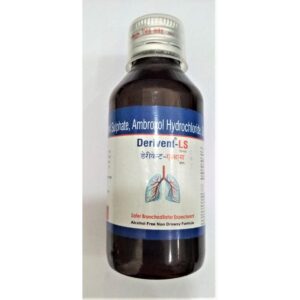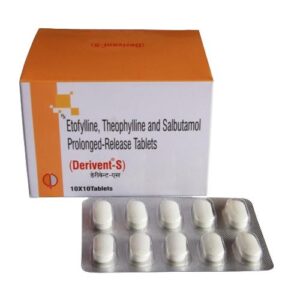SALBUTAMOL + ETOFYLLINE + GUAIPHENESIN
Salbutamol: Salbutamol is a medication commonly used to treat asthma and chronic obstructive pulmonary disease (COPD). It is a bronchodilator that works by relaxing the muscles in the airways, allowing for easier breathing.
The medication is typically administered through an inhaler or nebulizer, which allows the medicine to be directly inhaled into the lungs. Salbutamol is also available in tablet and syrup forms for oral administration.
The recommended dose of salbutamol depends on the age and condition being treated. For adults and adolescents over the age of 12, the usual dose is 1 or 2 inhalations every 4-6 hours as needed. For children aged 4-11 years, the usual dose is 1 inhalation every 4-6 hours as needed. The dose for oral tablets and syrup may vary and should be determined by a healthcare professional.
Common side effects of salbutamol include headache, nervousness, shakiness, rapid heart rate (tachycardia), muscle cramps, and throat irritation. These side effects are usually mild and go away on their own. However, if they persist or worsen, it is important to consult a healthcare professional.
In rare cases, salbutamol can cause more serious side effects such as allergic reactions, chest pain, irregular heartbeat, and high blood pressure. If any of these symptoms occur, immediate medical attention should be sought.
It is worth noting that the above information is a general overview of salbutamol, and specific instructions and precautions may vary depending on the individual’s condition and the specific formulation and brand of the medication. It is important to follow the guidance of a healthcare professional and read the product label or patient information leaflet for detailed instructions and safety information.
Etofylline: Etofylline is a drug that is primarily used to treat conditions such as asthma, chronic obstructive pulmonary disease (COPD), and other respiratory disorders. It is a bronchodilator, meaning it works to relax and widen the airways in the lungs, making it easier for the patient to breathe.
The mechanism of action of Etofylline involves inhibiting the enzyme phosphodiesterase, which leads to an increase in cyclic adenosine monophosphate (cAMP) levels. This increase in cAMP causes the smooth muscles in the airways to relax, resulting in bronchodilation. Etofylline also has anti-inflammatory effects, which further helps in reducing respiratory symptoms.
When it comes to dosage, the appropriate amount of Etofylline can vary depending on the patient’s age, weight, and condition being treated. It is typically taken orally as tablets or capsules. It is important to follow the prescribed dosage and instructions given by the healthcare provider.
As with any medication, there can be potential side effects associated with the use of Etofylline. Common side effects may include headache, nausea, vomiting, stomach discomfort, restlessness, and increased heart rate. These side effects are usually mild and temporary. In rare cases, more severe side effects such as allergic reactions, chest pain, irregular heartbeat, and seizures may occur. If any severe side effects are experienced, immediate medical attention should be sought.
It is important to note that Etofylline may interact with other medications and substances, such as caffeine and certain antibiotics, so it is crucial to inform the healthcare provider about all other medications being taken.
Overall, Etofylline is a bronchodilator that helps to relieve respiratory symptoms in conditions such as asthma and COPD. It works by relaxing the airway muscles and reducing inflammation. Adhering to the prescribed dosage and discussing any concerns or potential drug interactions with a healthcare provider will ensure the safe and effective use of Etofylline.
Guaiphenesin: Guaifenesin, also known by the brand name Mucinex, is an expectorant drug commonly used for the relief of cough and congestion associated with respiratory conditions such as the common cold, bronchitis, and sinusitis.
Mechanism of Action:
Guaifenesin works by increasing the volume and reducing the viscosity of respiratory tract secretions. It acts by stimulating the flow of respiratory tract secretions, which helps to loosen and thin mucus in the airways. This action promotes the effective removal of mucus and phlegm, making it easier to cough up and clear the airways.
Dosage:
The typical oral dose of guaifenesin for adults is 200-400 mg every 4-6 hours, not exceeding a total dose of 2.4 grams per day. However, the specific dosage may vary depending on the strength and formulation of the medication. It’s important to carefully follow the instructions provided by the healthcare professional or the package label.
Side Effects:
While guaifenesin is generally well-tolerated, it may cause some common side effects, including:
1. Nausea
2. Vomiting
3. Upset stomach
4. Dizziness
5. Headache
6. Drowsiness
7. Rash or itching
If any of these side effects persist or worsen, it is recommended to consult a healthcare professional promptly.
It’s worth noting that guaifenesin is usually combined with other ingredients in over-the-counter cough and cold medications, such as cough suppressants or antihistamines. In these combination products, there may be other side effects associated with the additional active ingredients.
As with any medication, it’s important to speak with a healthcare professional or pharmacist before starting guaifenesin, especially if you have any pre-existing medical conditions or are taking any other medications, to ensure its safety and effectiveness for your specific situation.



